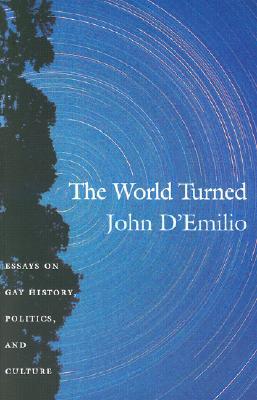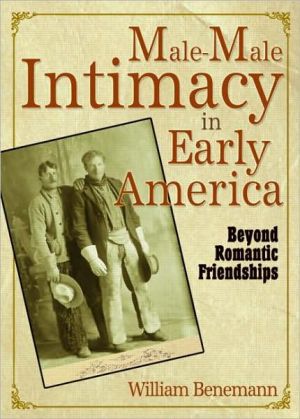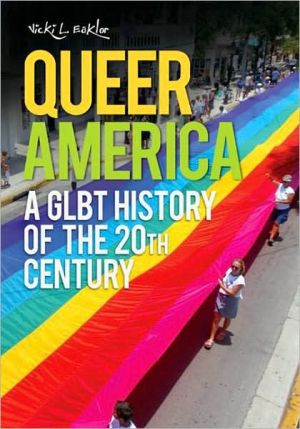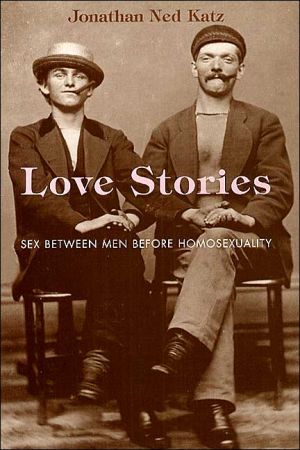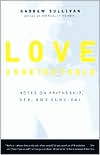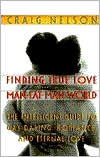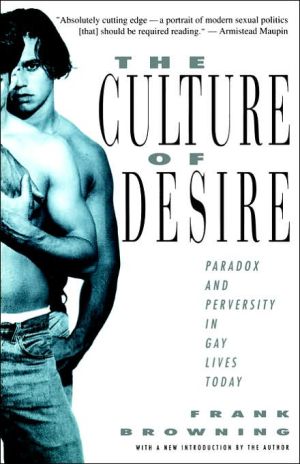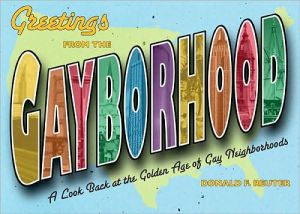The World Turned: Essays on Gay History, Politics, and Culture
Something happened in the 1990s, something dramatic and irreversible. A group of people long considered a moral menace and an issue previously deemed unmentionable in public discourse were transformed into a matter of human rights, discussed in every institution of American society. Marriage, the military, parenting, media and the arts, hate violence, electoral politics, public school curricula, human genetics, religion: Name the issue, and the the role of gays and lesbians was a subject of...
Search in google:
Something happened in the 1990s, something dramatic and irreversible. A group of people long considered a moral menace and an issue previously deemed unmentionable in public discourse were transformed into a matter of human rights, discussed in every institution of American society. Marriage, the military, parenting, media and the arts, hate violence, electoral politics, public school curricula, human genetics, religion: Name the issue, and the the role of gays and lesbians was a subject of debate. During the 1990s, the world seemed finally to turn and take notice of the gay people in its midst. In The World Turned, distinguished historian and leading gay-rights activist John D'Emilio shows how gay issues moved from the margins to the center of national consciousness during the critical decade of the 1990s. In this collection of essays, D'Emilio brings his historian's eye to bear on these profound changes in American society, culture, and politics. He explores the career of Bayard Rustin, a civil rights leader and pacifist who was openly gay a generation before almost everyone else; the legacy of radical gay and lesbian liberation; the influence of AIDS activist and writer Larry Kramer; the scapegoating of gays and lesbians by the Christian Right; the gay-gene controversy and the debate over whether people are "born gay"; and the explosion of attention focused on queer families. He illuminates the historical roots of contemporary debates over identity politics and explains why the gay community has become, over the last decade, such a visible part of American life. About the Author John D'Emilio is Professor of History and Gender and Women's Studies at the University of Illinois at Chicago. He is the author of Sexual Politics, Sexual Communities: The Making of a Homosexual Minority in the United States, 1940-1970 and Intimate Matters: A History of Sexuality in America (with Estelle B. Freedman). He was the first director of the National Gay and Lesbian Task Force's Public Policy Institute. Library Journal Leading gay activist D'Emilio is one of the great pioneers of gay history. . . . The 16 pieces collected here . . . blend together into a vivid portrait of gay thought in the past 15 years. . . . All academic libraries will want this title, and many public libraries need to consider it as well because the essays are not only inherently interesting but also clearly and accessibly written.
The World Turned\ Essays on Gay History, Politics, and Culture \ \ By John D'Emilio \ DUKE UNIVERSITY PRESS\ Copyright © 2002 Duke University Press\ All right reserved.\ ISBN: 0822330237\ \ \ \ Chapter One\ Homophobia and the Course of Post-World War II American Radicalism: The Career of Bayard Rustin\ Since the 1970s, gay and lesbian history has emerged as a vibrant new area of knowledge. Combining the inventiveness of the skilled detective with the insight of the finest cultural critic, a relatively small group of historians has opened unexpected startling vistas on the past. Although the better part of the job of recuperating these lost worlds is still to come, enough has been done to justify a heady sense of accomplishment.\ While lesbian history has forged strong intellectual tics with women's history and thus travels across the broad terrain mapped by gender studies, the historical literature on male homosexuality, at least that written about the United States, has for the most part remained curiously centered on itself. Not only is it, as one would expect, primarily about men whose erotic desire draws them toward other men, but it also focuses relentlessly on those aspects of their lives in which gayness is central-on the construction of identity, the evolution of urban subcultures and communities, the forging of a political emancipation movement. Even when the literature moves beyond these topics,into areas such as cultural representations and the elaboration of scientific theories of sexuality, the point has generally been to assess how these men have been oppressed.\ To characterize the writing of gay American history in this way is not to fault it. It seems almost foreordained that these would be the topics initially to capture attention; they are the ones that most readily could be excavated through scholarly digging. But it is also true that the steady focus on gayness-either gay life or gay oppression-threatens to obscure the bulk of gay historical experience. Most men who desired men did not lead queer-centered social lives, and even those who did would have passed much of their time-in work, politics, worship, voluntary associations, and civic affairs-in nongay contexts. How do we draw this experience into the orbit of gay history? How do we avoid writing a history of marginalized men that, ironically, reproduces the very marginality gay oppression attempts to enforce?\ My current project, a biography of Bayard Rustin, did not begin as an exploration in gay history. Rather, I wanted to study the 1960s. Personally, those times still resonate emotionally for me. For better or worse-though I like to think better-I am a product of the 1960s. That decade shaped irrevocably my outlook on life. Intellectually, as someone who regularly teaches courses on the sixties, I have also felt compelled to reexamine that time, as I watch the complex emotional responses of my students. Initially thrilled by the optimism, idealism, and power of the civil rights and student movements, they also become disturbed by what they see as the outcome: a nation spinning out of control, cynical, disillusioned, and fractured into separate identity movements. The sense that I carried away from those years-of a revolutionary moment greater than the sum of its individual parts-seems harder to grasp at the remove of a generation.\ Rustin's career, which has not received much play in the writing about post-World War II struggles for peace and justice, caught my attention for a number of reasons. For one, the broad range of his interests offered an opportunity to explore the connections between several movements. Through his work with the Congress of Racial Equality and with A. Philip Randolph in the 1940s, and with Martin Luther King Jr. in the 1950s, Rustin was certainly as responsible as anyone for injecting Gandhian nonviolence into the heart of the struggle for racial equality. He was also at the center of the pacifist circles that kept alive a critique of Cold War militarism, sparked the first demonstrations against the nuclear arms race, and stood ready to mobilize as the Johnson administration escalated the war in Vietnam. Rustin was fiercely internationalist as well. He worked closely with European pacifists, such as those in the Campaign for Nuclear Disarmament in Britain, and, keenly attuned to the historical significance of decolonization, with African liberation leaders such as Kwame Nkrumah of Ghana, Nnamdi Azikiwe of Nigeria, and Kenneth Kaunda of Zambia. To all these efforts, Rustin brought the skills of a master strategist and a compelling vision of revolutionary possibilities. It would not be an exaggeration to claim that, more than anyone else in the postwar era, he was a bridge linking the African American freedom struggle, peace campaigns, and a socialist dream of economic democracy.\ Rustin's career also intrigued me because, in the mid-1960s, he proposed a road not taken. During the critical years from 1963 to 1966, as the force of the civil rights movement provoked a wave of support for social and economic reforms not seen since the mid-1930s, Rustin argued that radicals had to engage directly the political process. Just when the line between radical and liberal was opening into an unbridgeable chasm, just when many student radicals were embarking on an eternal romance with street action, Rustin urged a transition "from protest to politics." At the time, militants tended to scorn Rustin's ideas. Many of his longtime associates argued then-and have continued to claim-that Rustin's strategic call was simply one manifestation of a more generalized turn to the right. In retrospect, with our ability to sec how the radical war on liberalism helped to usher in a generation-long conservative hegemony in American politics, his approach seems to me less suspect. Thus, Rustin's career appeared as a promising vehicle for exploring afresh the achievements and failures of the 1960s.\ That Rustin was also a gay man, and publicly identified as such in an era when the stigma attached to homosexuality was heavy, was a bonus. But I imagined his sexuality safely contained in the corner labeled "personal life," and saw it raising interesting, but secondary, questions that were not essential to the story of politics I wished to tell.\ As my research has progressed, Rustin's sexuality has resisted this ghettoization. It appears, increasingly, inescapable, injecting itself everywhere. I am coming to believe that it molded his public life and shaped the response of others to him and to his ideas. In other words, it occupies not a peripheral but a critical place in Rustin's biography and, by extension, in the history of the 1960s. Rustin's life suggests ways that gay history, by bursting out of its ghetto, can inform new ways of understanding critical moments and core topics in American history.\ In the rest of this chapter, I will trace in broad outline Rustin's life and career. Along the way, I will pause to consider the moments when his sexual identity erupted into public view. Finally, I will speculate about the ways that I think his homosexuality shaped his strategic thinking in the mid-1960s, conditioned the reactions of others to him, and propelled, eventually, his alleged turn to the right.\ * * *\ Bayard Rustin was born in 1912 into an African American family in West Chester, Pennsylvania, a Quaker-settled area that had been a stop on the underground railroad for runaway slaves. His grandmother, Julia, who raised Bayard as her own child, was an early member of the NAACP. Rustin excelled in high school as a scholar, athlete, and singer, and he also displayed a willingness early on to challenge racial discrimination. In the mid-1930s, he made his way to New York City, which remained his home for the rest of his life.\ Living in Harlem and attending City College, Rustin found himself in the midst of the unruly politics of Depression-era New York. Along with many Americans of conscience in the 1930s, he was drawn to the Communist Party. Rustin's Quaker beliefs, expressed during these years by participation in work-study projects of the American Friends Service Committee, only added to the attractiveness of the communist movement, for during the Popular Front period the party seemed to be against both war and fascism. Rustin joined the Young Communist League (YCL) and was active in the American Student Union, a major campus-based organization in which communists were influential. Yet, like many others, he eventually found himself alienated by the party's subservience to Moscow. After Hitler's invasion of the Soviet Union in June 1941, YCL leaders told Rustin to stop his activities for racial justice. Rustin broke with the party and remained deeply distrustful of it for the rest of his life.\ In the months just before his split with the party, Rustin embarked on two critical political relationships. Earlier in 1941, he had met A. Philip Randolph, the black socialist labor leader who had recently called for an African American march on Washington. With Randolph leading a charge of the black masses, Rustin was naturally attracted to the older, more experienced leader, and he began working in the youth section of the organization. A. J. Muste was the other older radical to whom Rustin was drawn. Muste, whose background included years at Brookwood Labor College in the 1920s and 1930s and involvement with the American Trotskyist movement, had recently become director of the Fellowship of Reconciliation (FOR), the leading Christian-pacifist organization in the United States. He believed pacifists must engage in more than moral witness against injustice; they had to build a movement for permanent change. At Muste's invitation, Rustin joined the Fellowship's staff in September 1941 and stayed for the next twelve years.\ It may seem odd to describe the war years as an exciting moment for American pacifists, but such was their characterization of the times. The worldwide conflagration created an elan, an intense solidarity that drove the truest believers to ever greater sacrifices of time and energy. Rustin traveled across the country, speaking to church and student groups, signing up new members, and visiting the relocation camps where Japanese Americans were incarcerated. For Rustin, a good bit of the promise of this first paying job as an agent of social change came from the knowledge that he was breaking new ground. Along with James Farmer and George Houser, two other young staff members of the FOR, Rustin was expanding the group's mission into the field of race relations. They were building a new interracial organization, the Congress of Racial Equality (CORE), dedicated to the application of Gandhian techniques to the struggle for racial equality. During the 1940s, they conducted training workshops and embarked on action projects, desegregating restaurants, drugstore lunch counters, skating rinks, and theaters. Rustin also served as the FOR's liaison to Randolph's March on Washington organization. Here was an authentic working-class vehicle, and Rustin strove to inject Gandhian nonviolence into this urban mass movement. After one of its major conferences, Rustin wrote enthusiastically to Muste that "Randolph really `hit the gong.' We had a superb meeting.... [he] spoke in a way that convinced me that he is really concerned to develop an understanding and use of non-violence by the American Negro."\ Early in 1944, Rustin was jailed for refusing induction. He entered a federal prison system that had been flooded by conscientious objectors whose hunger strikes and work stoppages were disrupting the routines of guards and inmates alike. Rustin plunged into these activities, challenging segregation and mail censorship, fomenting strikes among the prisoners, and, in the process, deepening his commitment to a hybrid of Gandhian, Quaker, and Marxist teachings. The prison years convinced Rustin that Gandhianism was the gospel of the future, and that the postwar years would require a steel-like commitment to militant action.\ By the time he was released from prison in June 1946, the Cold War was becoming national dogma. Pacifists found themselves increasingly isolated and were forced into symbolic forms of protest. Race relations, on the other hand, seemed to offer a more promising field of action. In 1947, Rustin and George Houser, acting through CORE, organized a test of bus company compliance with a Supreme Court decision banning segregated seating in interstate travel. Riding through the upper South, the members of the "Journey of Reconciliation" used Gandhian techniques and rallied black communities wherever they traveled. Rustin and three others also faced arrest and conviction, leading to another prison sentence. In 1948, pacifists joined forces once again with Randolph, who was mobilizing against military segregation. Under prodding from Rustin, Randolph promised a campaign of civil disobedience, which opened new opportunities for Rustin's message of nonviolent resistance to sink roots into African American communities. Meanwhile, Rustin spent much of his time on the road, leading workshops in which participants not only studied Gandhianism, but also exposed discrimination and instigated direct action campaigns.\ Because of the leadership qualities he displayed, Rustin attracted notice. Muste consciously mentored him, and strategized his development as a leader. The FOR sent him to meet with European pacifist leaders and to confer with Gandhi's followers in India. The peers with whom he worked remember the Rustin of the 1940s vividly. They were awed by the personal courage of a man who, in his solitary travels, regularly refused to comply with segregation and received beatings and jail sentences because of it. In my interviews with pacifists from this era, the two words that recurred most frequently in their description of Rustin were "prophetic" and "charismatic." Possessing a beautiful tenor voice, he could shift easily between speech and song, and he moved audiences to tears with his renditions of Negro spirituals. Rustin made an indelible impression wherever he traveled. In the eyes of one associate, Bayard was "a shining star." Another remembered "the magic about him." To many, he seemed destined to become an American Gandhi.\ By the early 1950s, opportunities for radical activity, even in the area of race relations, were vanishing. Aware of the rising agitation throughout Africa for independence, Rustin proposed shifting the FOR's focus to support for decolonization. The strategy was to inject nonviolent methods into the independence movements; the larger goal was to open a new space for agitation that might eventually loosen the Cold War grip on politics at home. After extended travels in Africa in 1952, Rustin returned home enthusiastic about the possibilities, and the FOR began raising money for his plans.\ And then the roof caved in. In January 1953, while on a speaking tour to promote his African plans, Rustin was arrested in Pasadena, California. Discovered in a parked car with two other men, he was convicted of violating California's lewd-vagrancy law and sentenced to sixty days. The Los Angeles Times reported the incident and, since Rustin's lectures on the West Coast had to be canceled abruptly, word spread quickly through pacifist circles.\ The Pasadena arrest was not the first time that Rustin's homosexuality was subjected to scrutiny. Sometime early in his tenure at the Fellowship, he and Muste discussed it. Whether Rustin raised the issue himself, or whether Muste initiated the dialogue, is uncertain, and the circumstances and content of these early talks have eluded me. Rustin's primary erotic interest was young white men in their late teens and early twenties, with whom he had ample opportunity for contact through his work. Perhaps rumors about Rustin's approaches had reached Muste. Or, the quick intense bond that A. J. and Bayard formed (almost everyone who knew them during the 1940s referred to it as a father-son relationship characterized by mutual affection and respect) may have impelled Rustin to turn to Muste for guidance. In any case, Rustin's sexuality was grist for gossip among female staffers at the FOR, some of whom were smitten by his charm and good looks. Moreover, by 1943 Bayard was in a relationship with Davis Platt, a nineteen year old whom he had met at a conference, and Platt was now a Columbia student, visiting Rustin frequently at the FOR offices across the street from the campus. Platt does not recall having to hide their intimacy from Muste and the rest of the staff, and so, before Rustin went off to federal prison in 1944, sexual matters had certainly surfaced.\ (Continues...)\ \ \ \ \ Excerpted from The World Turned by John D'Emilio Copyright © 2002 by Duke University Press\ Excerpted by permission. All rights reserved. No part of this excerpt may be reproduced or reprinted without permission in writing from the publisher.\ \
Preface1Homophobia and the Course of Postwar American Radicalism: The Career of Bayard Rustin32Placing Gay in the Sixties233Still Radical After All These Years: Remembering Out of the Closets454A Meaning for All Those Words: Sex, Politics, History, and Larry Kramer645Cycles of Change, Questions of Strategy: The Gay and Lesbian Movement After 50 Years786Organizational Tales: Interpreting the NGLTF Story997Why Is This Year Different From Any Other?1238The Clinton Election: Historical Perspectives at a Moment of Change1369Stonewall: Myth and Meaning14610Born Gay?15411What Does Gay Liberation Have to Do with the War in Bosnia?16512Laying Claim to Family17413Visions of Leadership: Remembering Ken Dawson19314My Changing Sex Life19915Then and Now: The Shifting Context of Gay Historical Writing21016A Biographer and His Subject: Wrestling with Bayard Rustin231Notes249
\ From the Publisher“John D’Emilio is the best sort of troublemaker, one who provokes us to see the world with fresh eyes. In this age of arcane academic jargon, D’Emilio writes with clarity and grace. As a historian who dares to walk where others fear to tread, D’Emilio brings an acute sense of time and changing social context to his accounts of sexuality, gender, race, class, politics, the economy, and their links. His careful empirical research provides solid ground for his considered interpretations. These essays are smart, sane, thoughtful, and a joy to read.”—Jonathan Ned Katz, author of Love Stories: Sex between Men before Homosexuality\ “This insightful and absorbing collection confirms John D’Emilio’s stature as the gay and lesbian movement's premier chronicler and analyst. D’Emilio is a rare scholar and activist whose writing is clear and direct. Each essay tells vivid stories, shares wisdom earned through participation and observation—all in an engaging and inclusive voice. This is one of the most interesting collections on contemporary gay and lesbian history yet to be published.”—Urvashi Vaid, columnist for The Advocate and long-time activist\ \ \ \ \ \ Library JournalLeading gay activist D'Emilio is one of the great pioneers of gay history. . . . The 16 pieces collected here . . . blend together into a vivid portrait of gay thought in the past 15 years. . . . All academic libraries will want this title, and many public libraries need to consider it as well because the essays are not only inherently interesting but also clearly and accessibly written.\ \ \ New City ChicagoProwling through the dense, exotic terrain of American pop culture, John D'Emilio returns with a detailed map that charts the migration of gays to the center of our national consciousness during the last decade. The scapegoating of gays by the Christian Right, the controversy simmering around the gay-gene theory, and the influence of the great AIDS activist Larry Kramer, are just a few of the topics surveyed in this collection of essays, all of which read like savvy coffeehouse banter rather than jargon-cluttered academics. . . . D'Emilio shows us that the world has indeed 'turned,' that instead of looking the other way, it faces us head-on, acknowledging our presence in ways it never has before.—Tony Peregrin,\ \ \ \ \ Lambda Book ReportJohn D'Emilio's writing should be required for every gay, lesbian, bi or trans person. . . . The World Turned is a profound work that provides historical context for a decade that was truly transforming.—Scott Blaine Swenson,\ \ \ \ \ Gay and Lesbian Review/WorldwideThe World Turned takes the supposed tension between activism and academia and kicks it to the curb. . . . D'Emilio makes a stirring case for moving beyond fragmented identity politics based on ethnicity or sexual orientation, and for an approach that 'turns outward. . . .' D'Emilio sees the 1990s as a decade of enormous social transformation in the political power of lesbians and gay men, a time when indeed 'the world turned.' Others have made this claim, but D'Emilio has enough historical perspective to make the case effectively.—Christopher Capozzola,\ \ \ \ \ Publishers WeeklyA rabble-rousing college student in the 1960s, a gay liberation activist from the 1970s on, and a former director of the National Gay and Lesbian Task Force's Public Policy Institute in the 1990s, University of Illinois history professor John D'Emilio witnessed first-hand the flowering of gay rights and gay acceptance in American culture, as well as the political backlash. He records these in The World Turned: Essays on Gay History, Politics, and Culture. The previously published personal essays, speeches, reviews and biographical sketches cover such subjects as the career of civil rights activist Bayard Rustin, the evolution of D'Emilio's sex life, the search for the "gay gene" and Pat Buchanan's homophobic star turn during the 1992 Republican National Convention. (Oct.) Copyright 2002 Cahners Business Information.\ \ \ \ \ Library JournalCollections of previously published academic essays are useful primarily because of the convenience they provide readers already interested in the author's work and glad to throw away their accumulated photocopies. But the essays and speeches collected here hold together in a more profound way. Leading gay activist D'Emilio (Univ. of Illinois, Chicago) is one of the great pioneers of gay history, having published the first academic monograph on the subject in 1983. He was also head of the Public Policy Institute of the National Gay and Lesbian Task Force. The 16 pieces collected here, which cover historical topics, contemporary issues, and personal essays, blend together into a vivid portrait of gay thought in the past 15 years, showing how the gay community became a vital part of American life during the 1990s. D'Emilio's historical interest in Bayard Rustin, the unsung hero of the civil rights era, dovetails well with his contemporary political commentary. There are also essays on the influence of AIDS activist and writer Larry Kramer, the gay gene controversy, the legacy of radical gay liberation, and more. All academic libraries will want this title, and many public libraries need to consider it as well because the essays are not only inherently interesting but also clearly and accessibly written. D.S. Azzolina, Univ. of Pennsylvania Libs., Philadelphia Copyright 2002 Cahners Business Information.\ \
